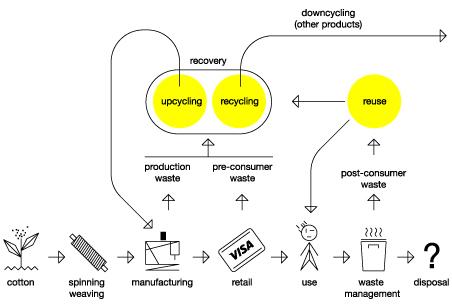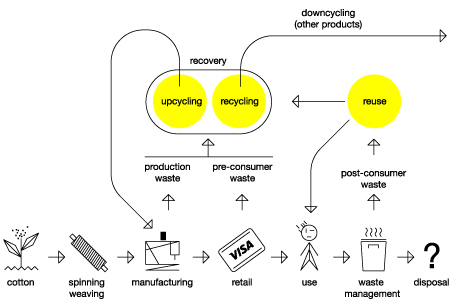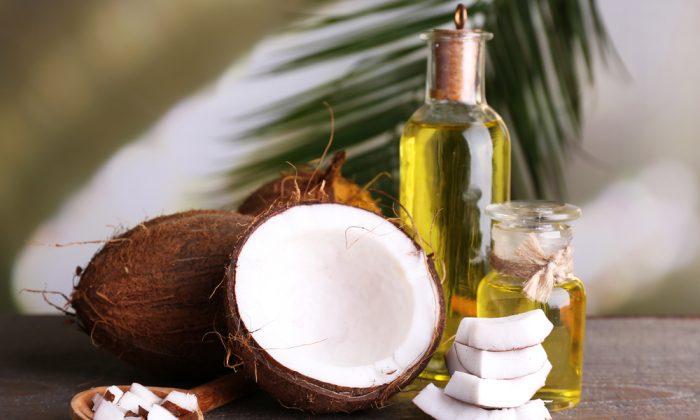Sunday, April 22, heralded Earth Day 2012, is a day launched by the Earth Day Network in 1970 to encourage yearly global events focusing on environmental awareness.
The Earth Day Network supports sustainable practices and rewards individual and larger organizational efforts for measurably reducing carbon emissions.
This work in raising awareness has impacted fashion by exposing the staggering amounts of water, energy, electricity, and other resources wasted by textile factories, in addition to the pollution generated by mass production.
New York and China are prime examples of massive textile waste.
“Over five percent of NYC’s residential waste stream consists of textiles like clothing and towels,” says GrowNYC.org, an environmental website. “All told, New Yorkers discard 193,000 tons of textiles every year in NYC, at a cost to taxpayers and our environment.
An article by Christina Dean on the eco-fashion forward website Ecouterre reveals that “an average of 234 tons of textiles are discarded every day into Hong Kong’s landfills, according to 2010 statistics.”
The founder of Redress, Dean adds: “This amount is surely a small blip compared to the vast amount of textiles discarded in China, the world’s largest garment manufacturer.”
The following is an overview of several promising green initiatives dedicated to reducing the fashion industry’s carbon footprint both nationally and abroad.
Clean by Design
On Monday, April 16, Vogue and the Council of Fashion Designers of America (CFDA) in partnership with the National Resources Defense Council (NRDC) launched Clean by Design—an effort that aims to dramatically decrease waste and pollution in textile production.
Senator Kirsten Gillibrand spoke Monday at the luncheon for the event to encourage reforms in how textiles are produced, as well as acknowledging New York’s leadership as the fashion capital of the world and setting the standard for other cities.
“We have to make sure we can impact our communities and our world in how we run our businesses,” she told Women’s Wear Daily.
Among Clean by Design’s supporters are some of fashion’s biggest names: Tory Burch, Zac Posen, Anna Wintour, Diane von Furstenberg, Francisco Costa, Mickey Drexler, Joseph Altuzarra, Derek Lam, and Stella McCartney.
Experts as well as a promotional video shown at the event revealed rivers in China polluted with dyes. They also explained that producing one ton of fabric consumes as much as 200 tons of water—an alarming figure considering that the demand for clean drinking water is expected to double over the next 40 years, according to the website Fashionista.
The website also addressed one of the crucial reasons it has been so difficult for the fashion industry to reform its environmental impact: Most brands produce out of China.
“Besides being on the other side of the globe,” writes Hayley Phelan in an article on Fashionista.com, “China’s production practices are anything but transparent, making it difficult for brands to have an accurate picture of what goes on in their own factories.”
According to the article, Linda Greer, director of the NRDC’s health and environment program, said: “What we found when we got there was that the standard of operation of many, if not most, factories was far below global standards and desperately needed to improve.”
She also said that “the curtain is rising,” and people can no longer turn a blind eye to what is happening anymore, even when it is occurring miles away.
Among its initial reforms, the NDRC developed 10 steps to significantly reduce waste and pollution.
Eileen Fisher’s ‘Green Eileen’
Designer Eileen Fisher is making great strides to green-clean her clothing company.
Not only did the company invest in two windmills to offset its own energy use through Support Native Energy, but it also changed the ways in which materials are produced.
For the spring collection, the brand followed the production stringencies of Bluesign, a textile standard for environmental protection and safety.
This means that the clothing would be using lightweight and low-impact silk, color-grown organic cotton, hemp, and alpaca, according to an article by Amanda Coen on Ecouterre.com. But shifting production was not always a smooth transition.
“Convincing one of its Chinese dye houses, which produces its silk, to make the Bluesign-required changes wasn’t easy, but it paid off in a big way,” writes Coen. “Right now, 10 percent of Eileen Fisher is Bluesign-certified.”
But that’s not all. In December, Eileen Fisher opened the first Green Eileen store in Yonkers, N.Y., which resells gently used Eileen Fisher clothing.
In Irvington, N.Y., both new samples and secondhand clothes are sold at the Eileen Fisher Lab Store. If the model works, more locations will be established.
According to the Green Eileen website, since 2009, Eileen Fisher has collected more than 50,000 garments and raised over $600,000 for its partner causes—programs that empower women and girls, including Girls Inc., the New York Women’s Foundation, and Women for Women International.
For textiles unsuitable for resale, Eileen Fisher upcycles them, turning them into useful objects like blankets, scarves, rugs, and more.
Trash to Trend
The latest buzz in the fashion world is upcycled clothing, popularized by Livia Firth, who wore an upcycled wedding dress to the 2010 Golden Globes as part of The Green Carpet Challenge.
Upcycling converts waste materials into new materials or products of better quality or higher value, unlike its counterpart recycling which processes used materials into new materials.
One innovative company, Trash to Trend (TTT), created by Estonian designer Reet Aus, “aims to extend the life of textile leftovers by bringing them back into the production cycle,” explained TTT’s communications director, Rachel Kinbar, to The Epoch Times.
“Designers will be able to sell their products and patterns, as well as freely share tutorials, regardless of location,” she said.
The way TTT works is through the Waste Mapping platform: sourcing where scraps are, how much material there is, and which fabrics are used. Then the unwanted materials find new homes with designers who incorporate them into their styles. The scrapped materials never hit landfills.
“Collecting the data is a bit tedious and it takes time,” Kinbar said, “but it’s an important element of connecting manufacturers and designers for the purpose of serial upcycling design. And that’s the innovative part of the Trash to Trend model—that upcycling design can be applied to serial production.”
She continued: “And, for the record, this isn’t just a fantastic idea. We know it can be done because we’ve done it!”
Based in Estonia for now, the company has plans to expand to other fabric suppliers and talented designers.
Kinbar explains in the blog Heartsleeves: “There are so many ethical and upcycling designers that we want to showcase, not to mention all the young new designers who are doing exciting things. Upcycling has so much potential, and we want to show that.
These initiatives represent but a small sampling of many other businesses and individuals working together to consciously improve environmental conditions and make the world a greener place to live in.











Friends Read Free